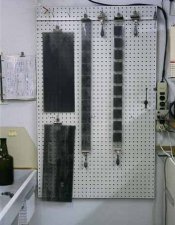a method for testing and some untested ideas
David Vestal wrote about his adaptation of Ralph Steiner's latensification techniques in Darkroom & Creative Camera Techniques, Nov/Dec 1993, page 43 e.p. (now Photo Techniques, whose web site shows the back issue still available). He uses the Kodak 5.5" round safelight and 7W lamp, half covered for Plus-X, and masked to a 1.75 inch square for Tri-X, at 15 to 20 minutes (old emulsions). He also finds that twice the time at half the light intensity gives the same speed gain in the shadows with less fog.
To test, he lights something like a Kodak Q-13 grey scale suspended well in front of a black background and shoots identically underexposed negatives so that he can compare the grey scale against the "absolutely" black background. He puts sections of this roll at distances of 7, 8.5, 10, and 12 feet from the safelight, making sure they don't cast shadows on each other, saving one strip with no latensification for comparison. He gives 15 minutes of exposure to the safelight. He develops the strips identically and suggests trying 10% to 15% extra development time as an option when latensifying. The best latensification exposure is the one with greatest density and detail increase in the shadows, but with minimal fog. Keep the light source at least 5 feet from a 36 exposure roll of 35mm or risk uneven coverage due to the inverse square law.
One thing I'm considering for myself is using a green LED off an adjustable 12V power source. A great source for these is superbrightleds.com, and I'm considering trying versions at:
Dead Link Removed
and
Dead Link Removed
(I also intend to try their amber and red versions for safelights and a dimmed green for development by inspection.)
DO NOT buy the 120VAC Edison screw base versions expecting to dim them, it won't work properly because of the electronics used to drive the LED. The 12VDC versions should be dimmable to the appropriate levels with a variable voltage DC "wall wart" transformer. Be sure the coverage of the LED is wide enough to cover the film evenly. A little sandpaper or emery cloth on the dome of the LED should work to diffuse it, or some frosted material in front of the LED. Some LEDs come with frosted or milky diffusion built in. The light bars at superbrightleds have 50 and 90 degree beams, so should be fine as is. Note that the cheaper 12" bar is lower output, while the more expensive one is brighter, but can be broken up into sections of 3 LEDs each. Either will need significant dimming.
Lee









